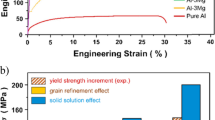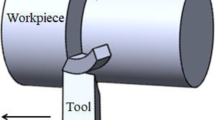Abstract
Recently developed aluminum-alloyed ultra-high carbon steels (UHC-steels) show high potential for industrial lightweight applications due to their exceptional mechanical properties at reduced density of 6.7–6.9 g/cm3. However, earlier publications highlighted that machining these steels results in excessive tool wear. The wear behavior was attributed to the intricate three-phase microstructure as well as the thermal properties of the material. This article aims to give further insight into the influence of tool geometry, cutting speed and uncut chip thickness on process forces and tool temperatures. Moreover, the effects on average strains, strain rates, temperatures in the primary shear zone and flow stress are discussed. The temperature load on the tool is calculated and validated via temperature measurements. The results indicate that the flow stress in the primary shear zone is affected by the strain and strain rate rather than by the shear zone temperature resulting in substantial strain hardening. The temperature measurements as well as the used analytical temperature model show consistently that temperatures above 900 °C can be easily exceeded at the rake face in dry machining of aluminum-alloyed UHC-steels and that the temperature is mainly determined by the cutting speed. Based on the results recommendations for the tool and process design are derived.








Similar content being viewed by others
References
Oyama T, Sherby OD et al (1984) Application of the divorced eutectoid transformation to the development of fine-grained, spheroidized structures in ultrahigh carbon steels. Scr Metall Mater 18(8):799–804
Sherby OD, Young CM, Conrad M, Walser B, Eldon M (1976) Superplastic ultra high carbon steel, US Patent #3.951.697
Sherby OD, Kum DW, et al. (1988) UHCS containing aluminum, US Patent #4.769.214
Lesuer DR, Syn CK et al (1993) The case for ultrahigh-carbon steels as structural materials. JOM 45:40–46
Taleff EM, Nagao M et al (1996) High-strain-rate superplasticity in ultrahigh-carbon steel containing 10 wt% Al (UHCS-10Al). Scr Mater 34(12):1919–1923
Denkena D, Koehler J, Dittrich MA (2014) Chip formation and tool wear in turning of aluminum-alloyed UHC-steels. Prod Eng Res Devel 8:415–421
Oxley PLB (1989) The mechanics of machining: an analytical approach to assessing machinability. E. Horwood, Halsted Press, Chichester
Jaspers SPFC, Dautzenberg JH (2002) Material behaviour in metal cutting: strains, strain rates and temperatures in chip formation. J Mater Process Technol 121:123–135
Stevenson MG, Oxley PLB (1970) An experimental investigation of the influence of speed and scale on the strain-rate in a zone intense plastic deformation. Proc Inst Mech Eng 184:561–576
Shaw MC (2005) Metal cutting principles, 2nd edn. Oxford University Press, New York, Oxford
Grzesik W (1999) Experimental investigation of the cutting temperature when turning with coated indexable inserts. Int J Mach Tool Manuf 39:355–369
M’Saoubi R, Chandrasekaran H (2004) Investigation of the effects of tool micro-geometry and coating on tool temperature during orthogonal turning of quenched and tempered steel. Int J Mach Tool Manuf 44(2):213–224
Hong SY, Ding Y (2001) Cooling approaches and cutting temperatures in cryogenic machining of Ti-6Al-4V. Int J Mach Tool Manuf 41:1417–1437
de Lacalle LNL, Lamikiz A, de Larrinoa JF, Azkona I (2011) Advanced cutting tools. Machining of hard materials. Springer, London, pp 33–86
Denkena B, Biermann D (2014) Cutting edge geometries. CIRP Ann—Manuf Technol 63(2):631–653
Acknowledgments
This work is funded by the Daimler AG. The authors would like to thank the Walter AG for providing the cutting tools used in this study.
Author information
Authors and Affiliations
Corresponding author
Rights and permissions
About this article
Cite this article
Denkena, B., Grove, T. & Dittrich, M.A. Flow stress and temperature considerations for orthogonal cutting of an aluminum-alloyed UHC-steel. Prod. Eng. Res. Devel. 9, 337–342 (2015). https://doi.org/10.1007/s11740-015-0627-6
Received:
Accepted:
Published:
Issue Date:
DOI: https://doi.org/10.1007/s11740-015-0627-6




